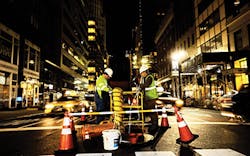Bridging the New York Enterprise Digital Divide
How C-RAN Will Enable Widespread Low-Latency Connectivity for Business in NYC —
To successfully participate in today’s increasingly digital economy, enterprises need to embrace cutting-edge Information and Communication Technology (ICT) as part of day-to-day operations and growth strategies. As technology has continued to evolve, many of today’s tools require immense bandwidth and readily available network connectivity — a commodity that is unfortunately lacking in many small to medium enterprise buildings. This has created a digital divide among enterprises in even the most connected cities in the world, including New York City.
With approximately 600,000 buildings and over 1 million parcels of land in NYC that require wireless coverage, the LECs alone do not have the resources to install equipment that will enable ubiquitous high-quality connectivity to all 600,000. As a result, large corporations have the opportunity to thrive with direct access to advanced wireless and wireline connectivity services via major telco providers, while their smaller counterparts struggle to maintain pace.
Manhattan Street Scene: ZenFi Nighttime Fiber Install
Fortunately, emerging wireless and connectivity enablement technologies such as 5G and Centralized Radio Access Network (C-RAN) are providing effective and affordable solutions that bridge the digital divide, and bring high-bandwidth, high-speed connectivity to enterprises of all sizes across all verticals.
In order to create an effective bridge across the enterprise digital divide, there must be a collaborative effort among building managers and telecom providers to bring high-quality connectivity to all enterprise buildings throughout the region. C-RAN solutions will help reduce the cost of connectivity by aggregating assets, centralizing costly resources such as Base Band Units (BBUs), and establishing new points of connectivity in the field with most cost-effective infrastructure such as Remote Radio Heads (RRHs) and Distributed Antenna Systems (DAS).
InvisiLight® Solution for Deploying Fiber
April 2, 2022Go to Market Faster. Speed up Network Deployment
April 2, 2022Episode 10: Fiber Optic Closure Specs Explained…
April 1, 2022Food for Thought from Our 2022 ICT Visionaries
April 1, 2022Replacing legacy mobile network architecture, C-RAN technology utilizes base station hoteling to move processing away from a single antenna back to a centralized location to support multiple antennas, introducing a transmission network known as fronthaul. When combined with a robust fiber backbone, this unique distributed architecture is capable of providing the dense network of fiber lateral splice points needed to support the large number of antennas served by each base station. In an effort to make this level of connectivity a reality, Mobile Network Operators (MNOs) are evolving their networks to support C-RAN solutions by bringing high-bandwidth fiber optic connectivity to a multitude of endpoints in a process known as Fiber-to-the-X (FTTx).
A NYC Kind of Network
In New York City, legacy fiber networks were built with low-access, high-capacity connections in mind, while copper networks were built with high-access, low-capacity in mind. By contrast, an effective mobile fronthaul fiber network blends the best qualities of each configuration to build the next generation of network architecture that can support C-RAN technology. Given the high-bandwidth, high-access connectivity needs of today’s enterprises, a new kind of network is not only ideal, but necessary.
Responding to this need, ZenFi Networks is a leader in the densification of New York City’s mobile network, and its carrier-neutral dark fiber network is deployed specifically to support densification and enable a new level of connectivity. By combining a legacy Access Network, which supports widely distributed wireless equipment interconnection and colocation, with an Express Network that links New York’s largest data centers, carrier hotels, and enterprise locations, this new model addresses the challenge of deploying fiber-to-the-antenna in a dense urban environment. As a result, this advanced network architecture makes the vision of a city laden with open access to fiber a reality, supporting Distributed Antenna Systems (DAS), small cells, and macro sites designed to enhance the wireless carrier networks and enable IoT and mobile densification.
By creating the necessary infrastructure to support C-RAN technology, this new network configuration will ultimately become a key facilitator of widespread digital applications, enabling cutting-edge 5G wireless and IoT technologies. In a world dependent upon the digital economy, C-RAN solutions coupled with a robust and accessible fiber network architecture, will bridge the enterprise digital divide and create growth opportunities for all organizations, regardless of their size.
About the Author






